Hey, just so you know, some of the links on this site are affiliate links. That means I may earn a small commission if you buy something through them. It doesn’t cost you anything extra, and it helps me keep this site running. Thanks for your support!
Introduction
The road to burning fat fast and achieving your weight loss goals is paved with the power of regular exercise. By incorporating effective exercises into your fitness routine, you can maximize calorie burn and accelerate your journey towards a healthier, leaner body.
In this article, we will delve into 15 highly effective exercises that are tailored to help you torch fat and achieve your fitness aspirations.
Through detailed instructions and insightful explanations, we will explore a diverse range of exercises, each offering unique benefits for fat burning and overall physical well-being. From high-intensity cardio activities to targeted strength training exercises, these workouts are designed to elevate your metabolism and optimize your body’s ability to shed unwanted fat.
Get ready to discover the transformative potential of these 15 exercises as we equip you with the knowledge and guidance needed to propel your fat-burning journey to new heights. Whether you’re a fitness enthusiast seeking fresh challenges or someone embarking on their weight loss odyssey, these exercises hold the key to unlocking your body’s potential for rapid fat burning.
Understanding Fat Burning and Exercise
Regular exercise plays a crucial role in burning fat and achieving weight loss goals. Here are some key points to help you understand how exercise contributes to calorie burn and facilitates weight loss:
1. Calorie Burn
When you engage in physical activity, your body burns calories for energy. The more intense the exercise, the more calories you burn. This calorie burn can create an energy deficit, leading to weight loss over time.
2. Exercise Intensity
Exercise intensity refers to how hard you are working during a workout. Higher intensity workouts, such as high-intensity interval training (HIIT) or strength training, can increase your metabolism, allowing you to burn more calories even after your workout is done.
3. Weight Loss Strategy
Exercise alone is not enough for significant weight loss. It should be combined with a balanced diet and other lifestyle factors. A comprehensive weight loss strategy includes:
- Creating a calorie deficit through exercise and diet
- Focusing on whole foods
- Managing portion sizes
- Ensuring adequate sleep and stress management
By understanding the relationship between exercise, calorie burn, and weight loss, you can design an effective fitness routine that aligns with your goals. Keep in mind that consistency is key – regular exercise and healthy habits over time will yield sustainable results.
Remember to consult with a healthcare professional or certified fitness trainer before starting any new exercise program to ensure it is suitable for your individual needs and abilities.
1. Skipping: A High-Calorie Burning Exercise
How to Perform Skipping Correctly for Maximum Calorie Burn
To perform skipping correctly, follow these steps:
- Start with good posture, engage your core, and jump lightly on the balls of your feet.
- Use your wrists to turn the rope and keep your elbows close to your sides.
- Land softly and maintain a consistent rhythm for optimal calorie burn.

Benefits of Skipping
Skipping offers several benefits for your body:
- Bone Density: Skipping is a high-impact exercise that can significantly increase bone density.
- Coordination: The repetitive motion of jumping rope improves coordination between your upper and lower body.
- Leg Strength: Jumping requires the use of your leg muscles, helping to strengthen them over time.
- Core Strength: Engaging your core while skipping helps to stabilize your body and strengthen your abdominal muscles.
- Posture: By practicing good posture during skipping, you can improve your overall posture in daily life.
- Cardiovascular Endurance: Skipping is an excellent cardiovascular workout that boosts endurance and burns a high number of calories in a short amount of time.
By incorporating these steps into your skipping routine, you can maximize calorie burn and reap the full benefits of this simple yet effective exercise.
2. Kettlebell Workouts for Strength and Cardio
Kettlebell workouts are a great way to improve both strength and cardiovascular fitness. These exercises involve dynamic movements that work multiple muscle groups at once, making them effective for burning calories and building lean muscle.
Benefits of Kettlebell Workouts
- Calorie Burning: Kettlebell workouts can burn a lot of calories. Some routines can even burn over 800 calories per hour.
- Combines Strength and Cardio: With kettlebell exercises, you get the benefits of both strength training and cardio in one workout.
- Engages Stabilizing Muscles: The unstable nature of kettlebells forces your body to use smaller muscles to stabilize yourself during the exercises.
- Improves Functional Strength: Since kettlebell exercises mimic everyday movements, they can help improve your strength for daily activities.
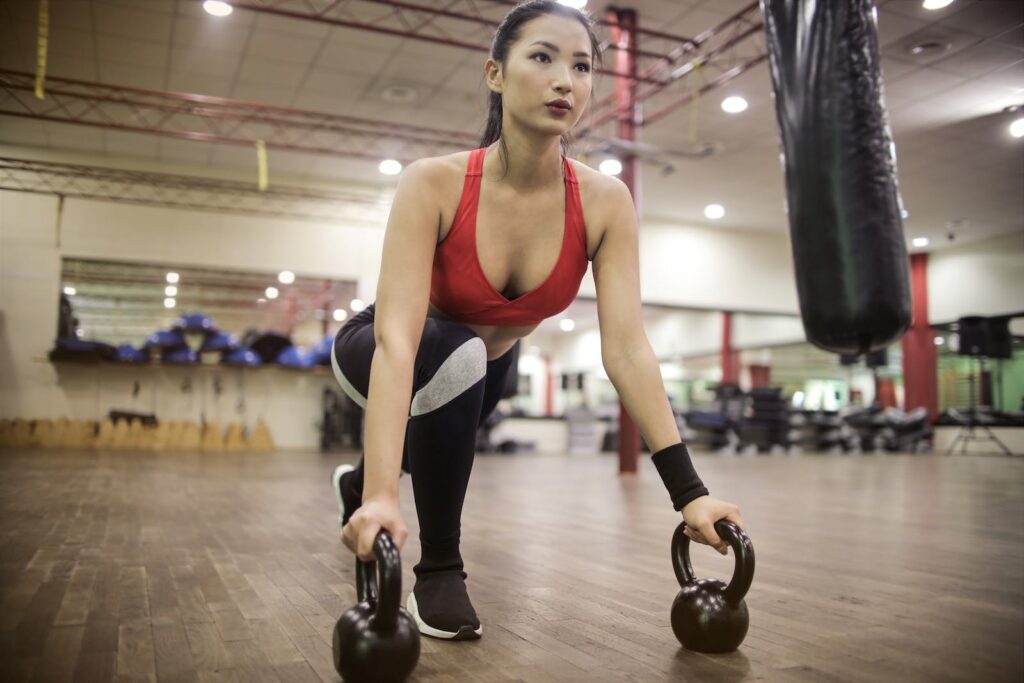
Why Choose Kettlebell Workouts
Incorporating kettlebell workouts into your fitness routine can have several positive effects on your body:
- Burns Fat: Kettlebell exercises are great for fat loss because they increase your heart rate and require a lot of energy.
- Builds Muscle: The resistance provided by kettlebells helps build lean muscle mass, giving you a toned appearance.
- Increases Endurance: Regular kettlebell training improves your cardiovascular fitness, allowing you to perform physical activities for longer periods without getting tired.
- Enhances Overall Strength: By working multiple muscle groups at once, kettlebell workouts improve your overall strength and functional fitness.
- Saves Time: Since you’re combining strength and cardio in one workout, you can get an effective session in a shorter amount of time.
Whether your goal is weight loss, muscle toning, or overall fitness improvement, kettlebell workouts offer a comprehensive solution that can help you achieve your objectives.
3. Wall Squats for Fat Burning and Stability
Wall squats are an excellent exercise for targeting fat burning and improving lower body stability. By engaging the muscles in your legs, hips, and glutes, this exercise not only helps you burn calories but also strengthens the muscles that support your body’s stability.
How to Perform Wall Squats with Proper Form
To perform wall squats with proper form, follow these step-by-step instructions:
- Stand with your back against a wall, feet shoulder-width apart.
- Slowly slide down the wall until your knees are bent at a 90-degree angle, or as close to it as possible.
- Keep your back straight against the wall and ensure that your knees are directly above your ankles.
- Hold the squat position for 30 seconds to 1 minute, or as long as you can maintain good form.
- Push through your heels and engage your leg muscles to return to a standing position.
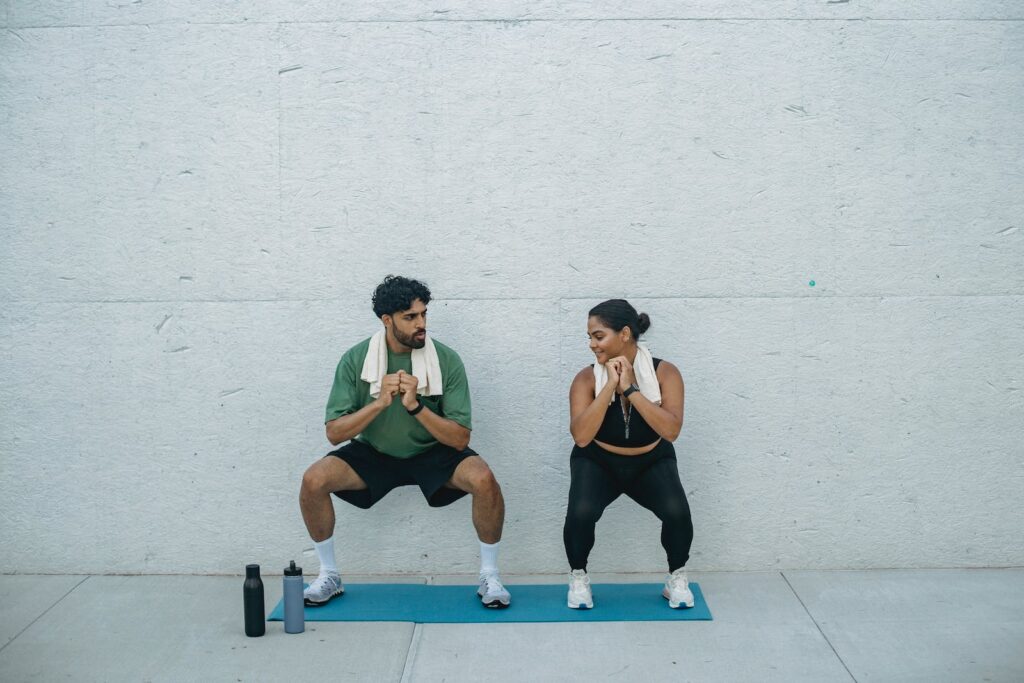
Benefits of Incorporating Wall Squats into Your Workout Routine
By incorporating wall squats into your workout routine, you can benefit from:
- Fat Burning: Wall squats engage large muscle groups in your legs, leading to increased calorie burn during and after the exercise.
- Lower Body Stability: This exercise targets the muscles that provide stability for movement, helping to improve balance and reduce the risk of injury.
- Muscle Strength: Wall squats work the quadriceps, hamstrings, glutes, and calves, helping to build strength and tone in these areas.
- Improved Posture: By maintaining proper form throughout the exercise, wall squats can help improve your overall posture.
Tips for Incorporating Wall Squats into Your Workout Routine
Incorporate wall squats into your workout routine by performing multiple sets of 10-15 repetitions. As you become more comfortable with this exercise, you can increase the duration of each squat or add weights to challenge yourself further.
Remember to consult with a fitness professional before starting any new exercise program, especially if you have any pre-existing conditions or injuries.
4. High-Rep Compound Strength Training for Calorie Burn
Keywords: high-rep compound strength training, muscle fibers, oxygen consumption
High-rep compound strength training offers several advantages for calorie burn and overall fitness. Here’s why it’s an effective strategy:
- Engagement of Multiple Muscle Fibers: High-rep compound exercises, such as lunges, squats, and deadlifts, activate a wide range of muscle groups simultaneously. This comprehensive engagement leads to a higher calorie burn during the workout and triggers a sustained after-burn effect as the muscles recover.
- Increased Post-Workout Calorie Expenditure: The intense nature of high-repetition training elevates oxygen consumption and energy expenditure during and after the workout. This can contribute to a higher overall calorie burn throughout the day, supporting weight loss goals.
- Efficient Use of Time: By targeting multiple muscle groups in one session, high-rep compound strength training optimizes workout efficiency, making it suitable for individuals with busy schedules.
Incorporating high-rep compound strength training into your exercise routine can enhance fat burning and promote overall physical conditioning.
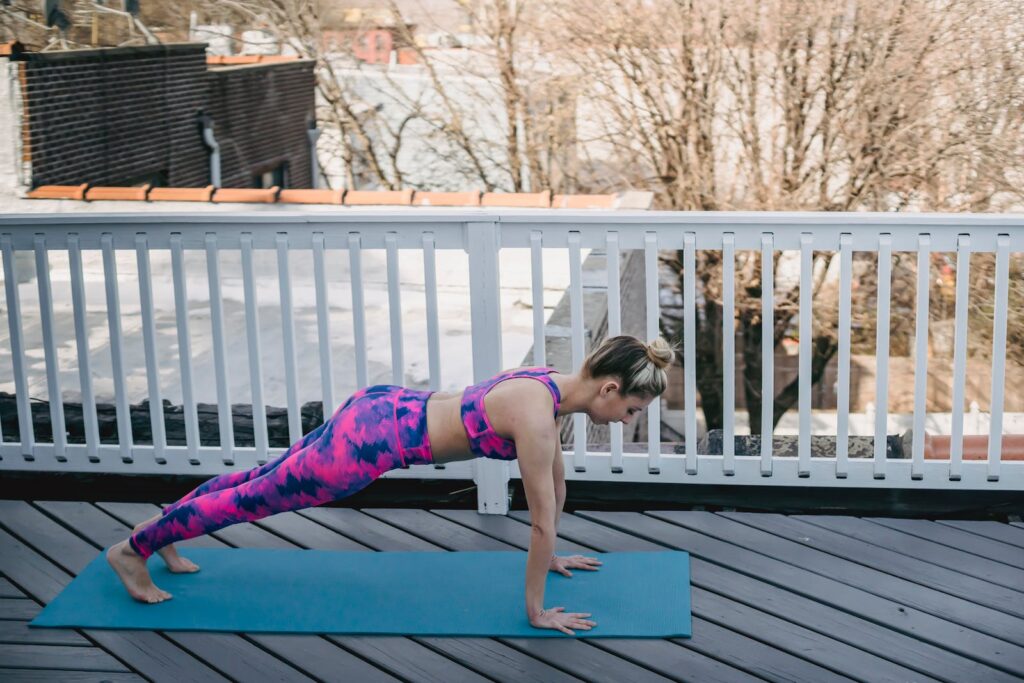
5. Running for Fat Loss and Leg Strength
Running is a popular aerobic activity that can help you burn calories and strengthen your leg muscles. Whether you’re looking to lose fat or build lean muscle in your legs, running can be an effective exercise option.
The Benefits of Running
1. Immediate Calorie Burning
Running is known for its ability to burn calories quickly. When you run, your body uses energy from stored fat to fuel your muscles. This can lead to weight loss and a reduction in body fat over time.
2. Long-Term Leg Muscle Development
In addition to burning calories, running also helps strengthen and tone your leg muscles. As you run, your quadriceps, hamstrings, calves, and glutes all work together to propel you forward. Over time, this repetitive motion can lead to increased muscle definition in these areas.

Tips for Effective Running
To make the most of your running workouts, consider incorporating the following tips:
- Start Slowly: If you’re new to running, begin with shorter distances or intervals of walking and running. Gradually increase your speed and duration as your fitness level improves.
- Mix Up Your Terrain: Varying the surfaces you run on (e.g., pavement, trails, hills) can challenge different muscles in your legs and prevent boredom.
- Include Strength Training: While running is great for leg strength, adding strength training exercises like squats and lunges can further enhance muscle development.
- Listen to Your Body: Pay attention to any signs of pain or discomfort during or after your runs. It’s important to rest and recover if needed to avoid injury.
Remember, consistency is key when it comes to seeing results from any exercise routine. Make sure to incorporate rest days into your schedule and listen to your body’s needs.
So lace up those running shoes and hit the pavement or trail!
6. Rowing for Full Body Workout and Calorie Burn
Rowing exercises provide a full-body workout, engaging the upper body, core, and lower body while effectively burning calories. Proper rowing technique is essential to ensure optimal muscle engagement and maximize the cardiovascular benefits of this exercise.
- Rowing targets multiple muscle groups simultaneously, making it a highly efficient full-body workout.
- The pulling motion engages the muscles in the back, arms, and shoulders while the pushing motion activates the muscles in the legs and core.
- The continuous and fluid movement of rowing helps in torching calories and improving cardiovascular endurance.
- Proper form and technique are crucial to prevent injury and ensure that the intended muscle groups are being effectively targeted.
- Rowing is a low-impact exercise, making it suitable for individuals with joint issues or those seeking a non-weight-bearing workout option.
- Incorporating rowing into your fitness routine can contribute to overall strength, endurance, and calorie expenditure.
Rowing offers a dynamic and comprehensive workout experience, making it an excellent choice for individuals looking to enhance their overall fitness level while prioritizing calorie burn and muscle engagement.

7. Kickboxing for Cardiovascular Endurance and Calorie Burn
Kickboxing is a great way to improve your cardiovascular endurance, burn calories, and have fun while working out. Whether you’re looking to lose weight, tone your muscles, or learn self-defense techniques, kickboxing can be a beneficial addition to your fitness routine.
Dynamic Cardio Workout
Kickboxing combines martial arts techniques with aerobic exercise, creating a dynamic and engaging workout. It involves a series of punches, kicks, knee strikes, and elbow strikes, performed in rapid succession. This constant movement elevates your heart rate and challenges your cardiovascular endurance.
Calorie Burn
Kickboxing is an excellent calorie-burning exercise. In fact, it can burn around 300-400 calories in just 30 minutes for an average-sized person. The combination of intense movements and full-body engagement contributes to the high calorie expenditure.
Muscle Engagement
Kickboxing engages multiple muscle groups throughout the body:
- The punches work your chest, shoulders, and arms.
- The kicks target your glutes, thighs, and calves.
- The rotational movements involved in throwing punches and kicks engage your core muscles and promote overall stability.
Self-Defense Skills
In addition to its fitness benefits, kickboxing can also enhance your self-defense skills. Learning proper techniques and practicing them regularly can improve your reflexes, coordination, and ability to defend yourself if necessary.
To get started with kickboxing:
- Join a kickboxing class at a local gym or fitness studio.
- Try online tutorials or instructional videos that guide you through the basic techniques and combinations.
Remember to start at a level that suits your fitness level and gradually increase the intensity as you become more comfortable with the movements.
Kickboxing offers a fun and challenging way to improve cardiovascular endurance, burn calories, tone muscles, and develop self-defense skills. Incorporating kickboxing into your exercise routine can add variety and excitement while helping you achieve your fitness goals.
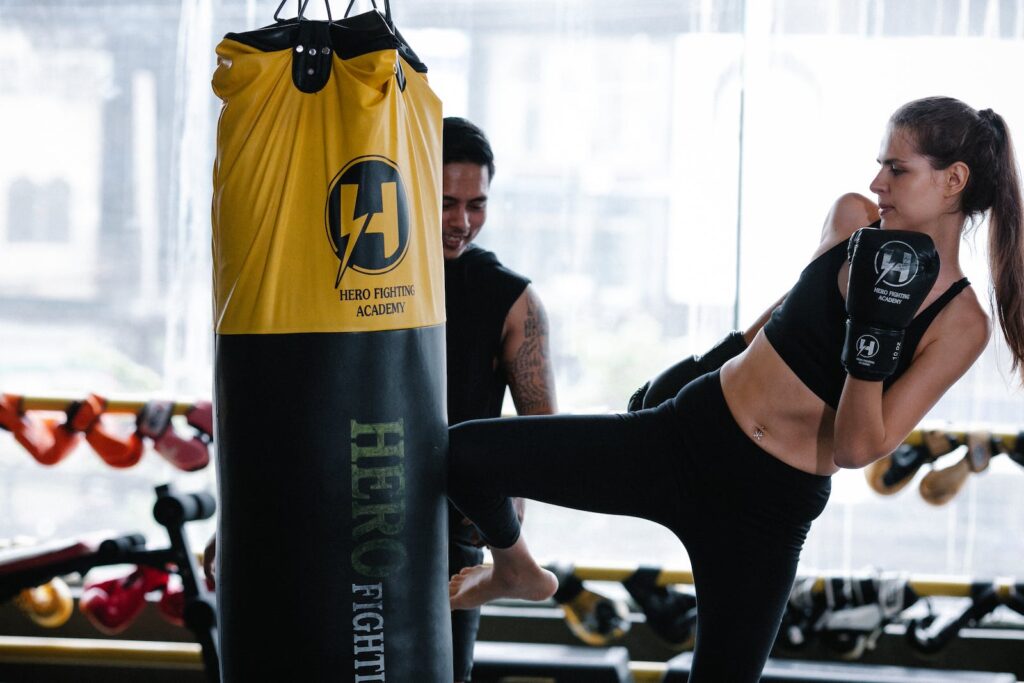
8. Swimming for Low-Impact Fat Burning
Swimming is a highly effective low-impact workout that can help you burn fat while being gentle on your joints. It offers numerous benefits for those looking to achieve their weight loss goals. Here’s why swimming should be considered as part of your fat-burning exercise routine:
Why Choose Swimming for Fat Burning?
- Non-weight-bearing exercise: Swimming is a non-weight-bearing exercise, meaning it doesn’t put stress on your joints like running or jumping. This makes it an excellent choice for individuals with joint issues or those who prefer low-impact workouts.
- Calorie-burning potential: Swimming can burn a significant amount of calories depending on the stroke and intensity level. On average, swimming freestyle at a moderate pace can burn around 500-600 calories per hour, while more intense strokes like butterfly and breaststroke can burn up to 700-800 calories per hour.
- Full-body workout: Swimming engages multiple muscle groups simultaneously, providing a comprehensive full-body workout. It targets muscles in the arms, shoulders, back, core, and legs, helping to build strength and tone the body.
- Cardiovascular endurance: Swimming is an aerobic activity that requires rhythmic breathing and continuous movement. By regularly swimming at a challenging pace, you can improve your cardiovascular endurance and increase your overall stamina.
- Versatile options: Swimming offers a variety of options to keep your workouts interesting and challenging. You can switch between different strokes such as freestyle, backstroke, breaststroke, and butterfly to target different muscle groups and vary the intensity of your workout.
How Swimming Helps in Burning Fat?
Swimming provides an effective way to burn fat without putting excessive strain on your body. Whether you prefer leisurely laps or intense interval training in the pool, incorporating swimming into your fitness routine can help you achieve your weight loss goals while improving your overall fitness level.

9. Bicep Plank Holds for Fat Burning and Muscle Building
Bicep plank holds are a challenging variation of the traditional plank exercise, specifically targeting the biceps, core muscles, and overall stability. This exercise not only promotes fat burning but also contributes to muscle building in key areas such as the arms and core. By engaging multiple muscle groups simultaneously, bicep plank holds offer a comprehensive workout that can be incorporated into your routine for enhanced strength and endurance.
How to Perform Bicep Plank Holds
To perform bicep plank holds:
- Start in a traditional plank position with your forearms on the ground and elbows aligned below the shoulders.
- From this position, slowly lift one forearm off the ground and place your palm flat on the surface.
- Repeat the same movement with the other arm, maintaining a stable plank position throughout.
By incorporating bicep plank holds into your workout regimen, you can effectively target your biceps, engage your core muscles, and work on overall stability while promoting fat loss and muscle development.
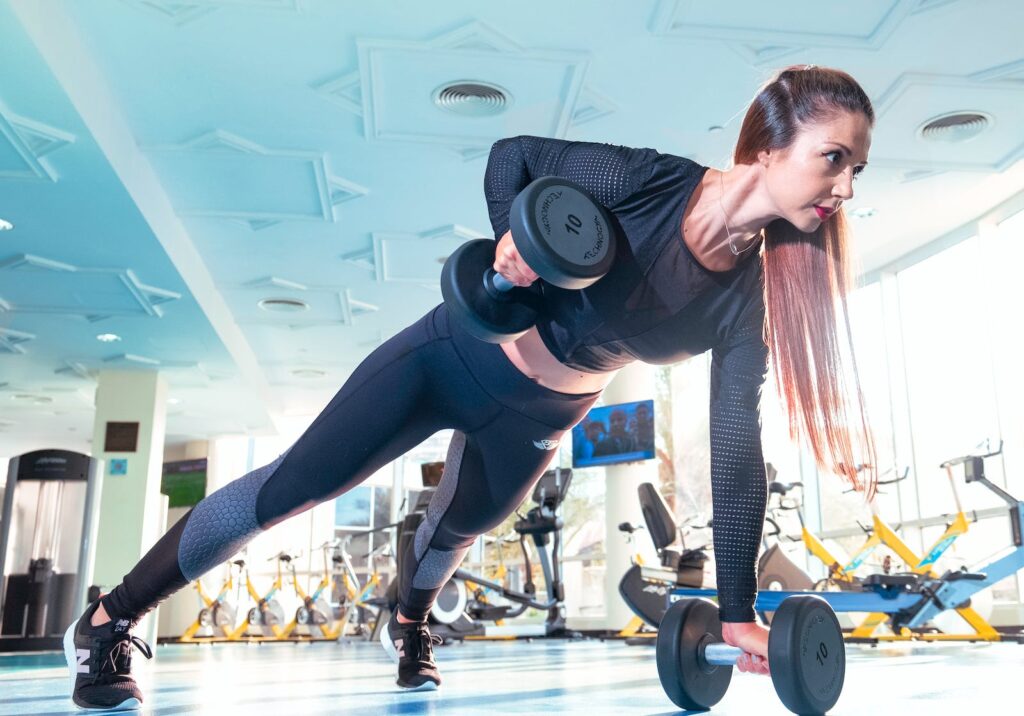
10. Russian Twist for Core Strength and Fat Burning
The Russian twist is a challenging sit-up variation that specifically targets the core muscles, making it an effective exercise for building core strength and burning fat.
How to do the Russian Twist:
- Sit on the floor with your knees bent and your feet flat on the ground.
- Lean back slightly so that your upper body forms a V shape with your thighs.
- Extend your arms straight out in front of you, keeping them parallel to the ground.
- Engage your core muscles and slowly twist your torso to the right side, bringing your hands towards the floor beside your hips.
- Pause for a moment, then twist your torso to the left side, bringing your hands towards the floor on the opposite side.
- Repeat this twisting motion for a desired number of repetitions.
Benefits of the Russian Twist:
- Engages the abdominal muscles to support spinal stability
- Targets obliques for improved waist definition
- Enhances overall metabolic rate through fat mobilization
Remember to start with a weight or difficulty level that’s appropriate for your fitness level and gradually increase as you get stronger.”
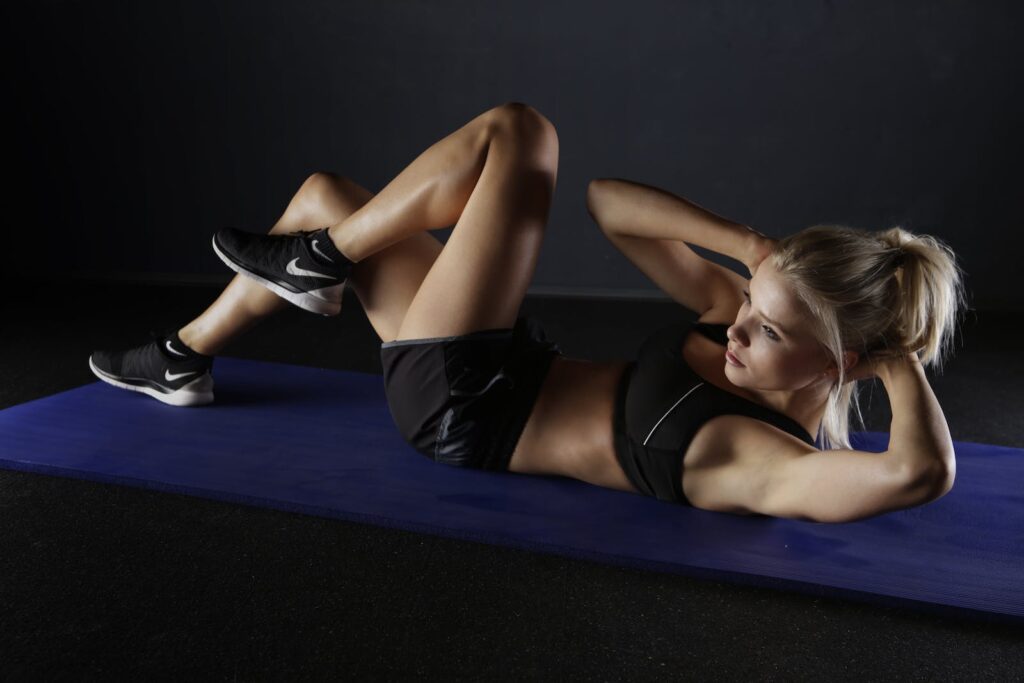
11. Plyometric Training for Power and Calorie Burn
Talking points:
- Highlight the explosive nature of plyometric exercises, which utilize quick and powerful movements to not only incinerate calories but also improve athletic performance through enhanced muscular power and coordination.
Plyometric training involves high-intensity, explosive movements that are designed to enhance power, strength, and overall athletic performance. These exercises typically involve jumping, bounding, and other dynamic movements that require rapid muscle contractions. Plyometrics not only contribute to calorie burn during the workout but also have a significant impact on improving muscular power and coordination.
The key benefits of plyometric training include:
- Calorie Burn: Plyometric exercises are highly effective in torching calories due to their high-intensity nature and full-body engagement.
- Power Development: These exercises focus on enhancing explosive strength, which is beneficial for athletes in sports requiring sudden bursts of energy.
- Muscular Coordination: Plyometrics help improve neuromuscular coordination, leading to better overall agility and balance.
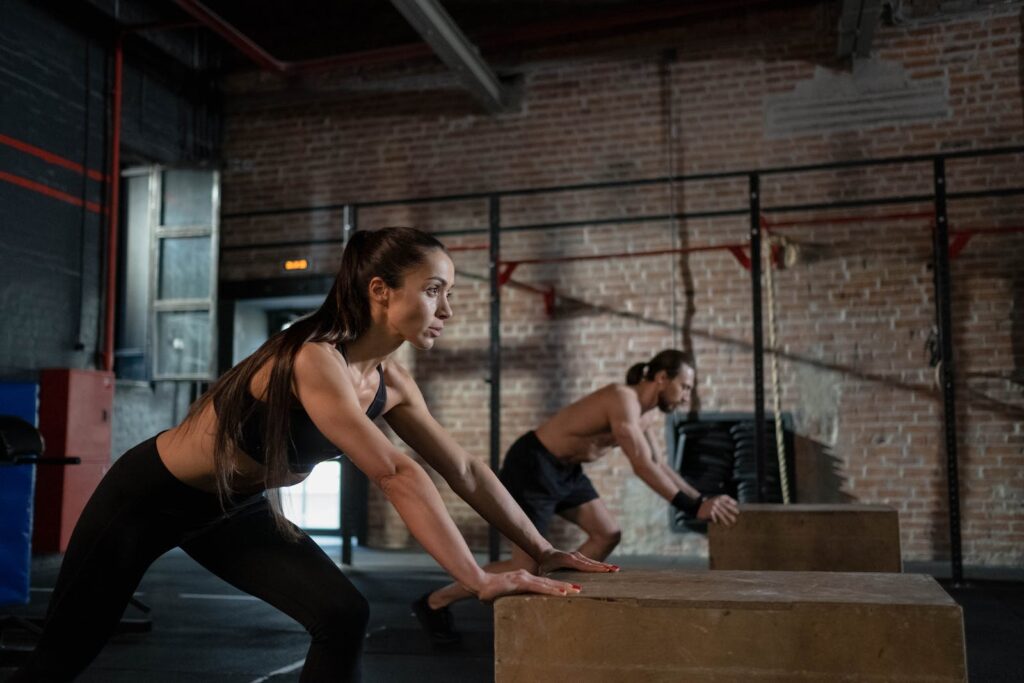
Incorporating plyometric moves like box jumps, squat jumps, and depth jumps into your workout routine can elevate your calorie-burning potential while also boosting your athletic performance. It’s important to gradually incorporate these exercises into your routine to minimize the risk of injury and maximize their effectiveness in burning fat and building power.
12. Cycling Intervals for Calorie Burn and Leg Toning
When it comes to getting the most out of your cycling workouts, incorporating interval training can be a game-changer. Not only does it help improve your aerobic conditioning, but it also targets your leg muscles for a sculpted lower body.
Why Cycling Intervals Work
The secret behind the effectiveness of cycling intervals lies in the alternating periods of high-intensity effort and recovery. By pushing yourself to go faster or tackle steeper inclines during the intense intervals, you’re able to significantly increase your calorie burn compared to steady-state cardio.
At the same time, the recovery periods allow your heart rate to come down slightly, giving you a chance to catch your breath before ramping up the intensity again. This cycle of pushing and recovering not only keeps things interesting but also helps build endurance and improve your overall fitness level.
Benefits of Cycling Intervals for Leg Toning
One area where cycling intervals really shine is in their ability to target and tone your leg muscles. As you pedal harder during the intense intervals, you engage more muscle fibers in your legs, including your quadriceps, hamstrings, calves, and glutes.
Over time, this repeated contraction and relaxation of the leg muscles can lead to increased muscle definition and strength. Plus, since cycling is a low-impact exercise, it puts less stress on your joints compared to activities like running or jumping.

Sample Cycling Interval Workout
Ready to give cycling intervals a try? Here’s a simple yet effective workout you can do on an indoor bike or out on the road:
- Warm up: Start with 5-10 minutes of easy pedaling to get your muscles warmed up and ready for action.
- Sprint intervals: Pedal at maximum effort for 30 seconds, aiming for a cadence (pedaling speed) of around 80-100 revolutions per minute (RPM). Follow each sprint with 1 minute of easy pedaling to recover.
- Hill climbs: Find a challenging incline (either on your indoor bike’s resistance knob or an actual hill) and maintain a steady pace for 2 minutes. Focus on pushing through your legs and keeping your upper body relaxed. Recover with 1 minute of flat road or easy pedaling.
- Repeat steps 2 and 3 for a total of 4-6 rounds, depending on your fitness level.
- Cool down: Finish off with 5-10 minutes of gentle pedaling to bring your heart rate back down and prevent any post-workout dizziness.
Remember to listen to your body and adjust the intensity or duration of the intervals as needed. As you get stronger, you can gradually increase the length of the sprints or hill climbs to continue challenging yourself.
So if you’re looking to spice up your cycling routine and take your calorie burn and leg toning up a notch, give cycling intervals a try. Your body will thank you!
13. Speed Training for Fat Burning and Metabolism Boost
Exploring the Metabolic Advantages Speed training, characterized by sprints and agility drills, offers significant metabolic advantages for fat burning and metabolism boost. These techniques trigger a high level of calorie afterburn post-workout and contribute to long-term upregulation of the metabolic rate.
How Speed Training Helps Burn Fat
1. Post-Workout Calorie Afterburn
Speed training techniques like sprints and agility drills elevate the heart rate and engage fast-twitch muscle fibers, leading to an increased calorie burn during the workout. Moreover, they stimulate a prolonged afterburn effect, where the body continues to burn calories at an elevated rate even after the training session has ended. This post-exercise oxygen consumption (EPOC) contributes to additional calorie expenditure, aiding in fat loss and weight management.
2. Long-Term Metabolic Rate Upregulation
Incorporating speed training into a fitness regimen can lead to sustained improvements in metabolic rate over time. The intense bursts of activity associated with speed training can enhance the body’s ability to efficiently utilize energy, ultimately contributing to an increase in overall metabolic rate. This heightened metabolism supports ongoing fat burning, making speed training an effective strategy for individuals seeking to optimize their weight loss efforts.
By understanding the metabolic benefits of speed training techniques, individuals can leverage these high-intensity workouts to maximize fat burning and achieve long-term improvements in metabolic efficiency without spending extended periods in the gym.

Incorporating Variety and Progression for Ongoing Results
Emphasize the importance of diversifying one’s workout routine with a range of fat-burning exercises to prevent plateaus and maintain motivation for long-term weight loss success.
Introduce the concept of exercise variety as a key strategy to prevent the body from adapting to a specific routine, leading to diminished results over time.
- Discuss the benefits of incorporating different types of exercises, such as cardio, strength training, and flexibility-focused workouts, to engage various muscle groups and energy systems.
- Provide examples of diverse fat-burning exercises, including high-intensity interval training (HIIT), plyometrics, bodyweight exercises, and resistance training, to illustrate the range of options available for creating a well-rounded fitness regimen.
Guide readers on how to gradually increase the challenge level or intensity of their workouts over time, ensuring continued progress and maximum calorie expenditure.
Explain the concept of progression in exercise programming, emphasizing the need to gradually increase workout difficulty to stimulate ongoing physical adaptations.
- Offer practical tips for implementing progression, such as adjusting workout duration, intensity, or complexity, to ensure that individuals continue to push their limits and avoid stagnation.
- Highlight the role of goal setting in facilitating exercise progression, encouraging readers to set specific targets for performance improvement or fitness milestones as a means of tracking their advancement.
Conclusion
In conclusion, it’s important to remember that exercise is a key factor in burning fat and reaching your weight loss goals. Throughout this article, we’ve explored a variety of exercises that can help you achieve these goals.
Here are some key takeaways:
- Strength training exercises, such as squats and lunges, can help build lean muscle mass and increase your metabolism.
- High-intensity interval training (HIIT) workouts are effective for burning calories in a short amount of time.
- Cardiovascular exercises, like running or cycling, can help improve your cardiovascular health and burn calories.
- Incorporating activities like swimming or dancing into your routine can make exercise more enjoyable.
It’s important to find activities that you enjoy and that fit into your lifestyle, as this will increase the likelihood of sticking with them long-term.
Before starting any new exercise program, it’s always a good idea to consult with a professional trainer or healthcare provider. They can provide guidance on proper form, intensity levels, and any modifications that may be necessary based on your individual needs or limitations.
Remember, consistency is key when it comes to seeing results from your workouts. Aim for at least 150 minutes of moderate-intensity aerobic activity or 75 minutes of vigorous-intensity activity each week, along with strength training exercises at least two days per week.
By incorporating these 15 fat-burning exercises into your fitness routine and staying consistent, you’ll be on your way to achieving your weight loss goals in no time!



